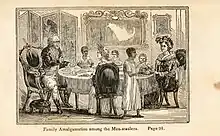
A shadow family was an unacknowledged child or children created by a white male slave owner with an enslaved black woman. Often they lived in physical proximity to their father, and a "married maverick reared a white family in the front of the house even as he reared a mulatto family in the back."[1]
In 1834, abolitionist George Bourne wrote, "In the houses of slave-holders, you behold young ladies elegantly attired and attended by their coloured sisters, children of the same father, and yet slaves. You recognise the driver of the carriage, the footman, and other domestics as manifestly the planter's own offspring...Two ladies of the first rank in Virginia affirmed, that the Northern citizens were totally incompetent to form any correct idea of a slave plantation. One of them remarked: 'We are called wives, and as such are recognised in law; but we are little more than superintendents of a coloured seraglio.' When the old slave-driver is dead, the 'boy' who is most like him is generally called by his title; and you are often surprised to hear a mulatto coachman or footman denominated captain, major or colonel. You ask the cause, and are informed; 'the man is so like his father, that if it were not for the colour of his skin, he is such a chip off the old block, that you could not know them apart.' "[2]
In the United States, the most notable example is Thomas Jefferson's six children with Sally Hemings.[3] However, the concept appears throughout the slave economy and influenced American race relations and social history long after slavery was abolished. For example, it has a strong presence in the novels of William Faulkner: "This extreme fear of miscegenation and existence of 'shadow families' is a wrong that Faulkner aims to resurrect from the past."[4]
The documentary record of these families is meager at best and, as a rule, "Nobody's shadow family from slavery times shows up on ancestry websites—not even Faulkner's."[5] Secrecy was of the utmost, for reasons both social and economic: "Sometimes, members of shadow families were abandoned or mistreated, either by the man or by his legitimate white heirs. A white father and husband rarely left his legitimate heirs for his shadow family...Polite Southern society, meanwhile, would criticize a man who did not keep his shadow family sufficiently secret."[6] Talking about shadow families in the public sphere was taboo; for example, when an 18th-century Tidewater woman took her husband to court for adultery and physical abuse, "Elizabeth Yerby transgressed all polite conventions by publicizing evidence of her husband's shadow family. By confronting George in front of William Brown, by drawing a guest's attention to mulatto children in her household, she humiliated her husband, damaging his community standing. This action was a misstep on her part."[7]
Scholar Arlene R. Keizer, writing about a work by the African-American artist Kara Walker, argues that she uses cut-paper silhouette to cast "the entire family, white and black, slavemasters, slavemistresses, enslaved 'concubines,' and children (following the condition of the mother), into shadow...a dysfunctional family portrait, referencing both the biological families engendered through slavery and the nation as a whole. Walker's work calls us to acknowledge and to witness the hypersexualized, often incestuous nature of these families and its implications for the American and African American collective imagination, but offers no path toward resolution."[8]
See also
References
- ↑ Williamson, Joel (1980). New people: miscegenation and mulattoes in the United States. Free Press. pp. 50–51. ISBN 9780807120354. OCLC 566271068.
- ↑ "Picture of slavery in the United States of America". HathiTrust. hdl:2027/nyp.33433075911556. Retrieved 2023-08-04.
- ↑ Lewis, Jan Ellen (2021-10-26). Family, Slavery, and Love in the Early American Republic: The Essays of Jan Ellen Lewis. UNC Press Books. p. 290. ISBN 978-1-4696-6564-1.
- ↑ Mitchell, Lisa (2023). Burning Down the House: Racial and Architectural Deterioration of the Southern Plantation Home in Works by William Faulkner (Thesis). Middle Tennessee State University. p. 114. ProQuest 2816696905.
- ↑ Thomas, George Porter (2023). "Faulkner's Subversive Genealogies". Faulkner's Families. Faulkner and Yoknapatawpha Series. University Press of Mississippi. pp. 136–146. doi:10.2307/jj.4256581.12. ISBN 9781496845030. JSTOR jj.4256581.12.
{{cite book}}:|work=ignored (help) - ↑ Clinton, Catherine (2010), Brooten, Bernadette J. (ed.), "Breaking the Silence: Sexual Hypocrisies from Thomas Jefferson to Strom Thurmond", Beyond Slavery, New York: Palgrave Macmillan US, pp. 213–228, doi:10.1057/9780230113893_13, ISBN 978-0-230-10017-6, retrieved 2023-07-08
- ↑ Riemsdijk, Tatiana Van (2005). "His Slaves or Hers? Customary Claims, a Planter Marriage, and a Community Verdict in Lancaster County, 1793". The Virginia Magazine of History and Biography. 113 (1): 46–79. ISSN 0042-6636. JSTOR 4250233.
- ↑ Keizer, Arlene R. (2008). "Gone Astray in the Flesh: Kara Walker, Black Women Writers, and African American Postmemory". PMLA. 123 (5): 1649–1672. doi:10.1632/pmla.2008.123.5.1649. ISSN 0030-8129. JSTOR 25501968. S2CID 162311249.
External links
- Williams, Caroline Randall (2020-06-26). "You Want a Confederate Monument? My Body Is a Confederate Monument". Opinion. The New York Times. ISSN 0362-4331. Retrieved 2023-07-15.